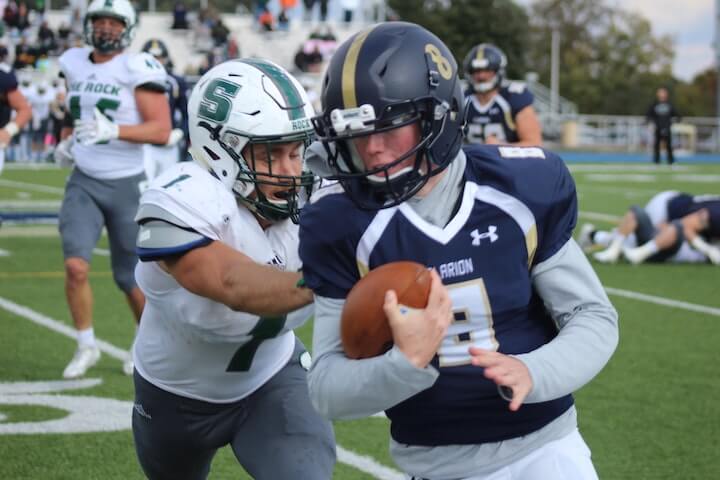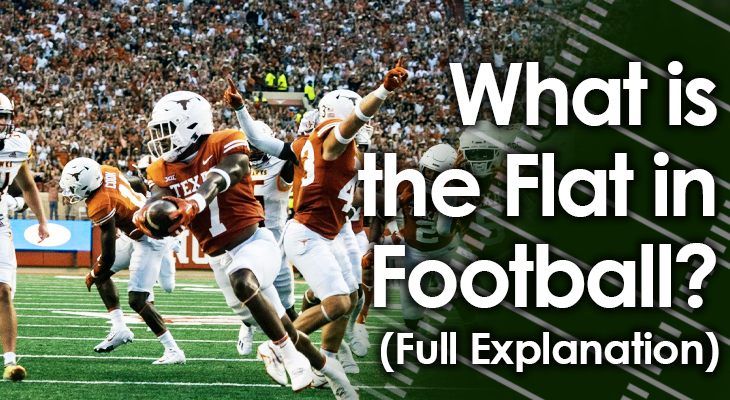When watching a game of football on TV, you might hear announcers refer to a section of the field called the Flat.
Specific names like this make it easy for announcers to refer to a section of the field without going into too much detail.
The Flat describes a specific region on the football field in relation to where the offense is set up and which players are on each site of the field.
Teams run passing routes specifically to this area of the field -- called Flat routes -- and the defense my cover this part of the field also.
Below, we'll take a closer look as to what the Flat in football is, as well as some of the routes run there and defensive responsibilities.
What is the Flat in Football?
It's a specific area of the field.
This Flat is the area of the field just outside of the tight end or the weak-side tackle.
The Flat will extend from the last player on each side of the interior line of scrimmage (either the tight end or tackle) all the way to each sideline.
It's essentially an imaginary rectangle.
In addition to extending all the way to the sideline width-wise, it also goes roughly eight yards beyond the line of scrimmage.
While the Flat is the most common term used to describe this part of the football field, it's also sometimes referred to as the bench area.
This is because players running passing routes toward the Flat will, essentially, also head toward the direction of each team's bench.

Passing Routes in the Flat
Passing routes run to the Flat are, naturally, called Flat routes.
Players who run these routes are most often players who line up in the backfield to start a play -- fullbacks and running backs, mainly.
Although tight ends and slot wide receivers sometimes run routes that end up in the Flat, but these are often referred to as Quick Out routes instead, due the shape of the routes.
Executing a Flat Route
The player running a Flat route will spring directly toward the sideline.
He'll take a sort of shallow arch toward the sideline to get some depth on the route, though the goal is to not go more than a few yards beyond the line of scrimmage.
The player running this route will take a more lateral path rather than a vertical one.
The entire time he's running the route, he should look back over his shoulder toward the quarterback, expecting to receive the pass.
At the same time, the player must be aware of where he is in relation to the sideline as he's running the route.
He should sprint toward the sideline, but also leave enough space in the field of play so the quarterback can still lead him with the pass.
If he does receive the pass, his job is to first secure it and then to turn upfield toward the sideline.
It's imperative that the player who catches the pass in the Flat secures the ball in his outside arm to protect it from defenders.
In most cases, the Flat route serves as a safety valve for the quarterback.
It's often the second or third progression for the quarterback, who will only go to the Flat route if his other primary routes aren't open.
Defending the Flats
Defending the Flats on the field can be very challenging for defenses.
While the area only extends about 8 yards beyond the line of scrimmage, it is wide, going from center-to-sideline on each side of the field.
Which means there's a lot of ground for defenders to cover.
In addition, players running routes into the Flat do so quickly. There isn't much time for defenders to get there to prevent the pass.
If they can't stop a completion, defenders must get to the ball carrier quickly and make a tackle without giving up too many yards.
Press Coverage
One of the most effective ways to defend against the flat is by instituting press coverage.
In this type of coverage, cornerbacks will line up much closer in to the LOS (line of scrimmage) than normal, which allows them to to move laterally to cover the flats easier.
Press coverage may also involve having safeties approach the line of scrimmage when they line up, rather than sticking deep in the middle of the field. Outside linebackers may also do the same.
These positions can either start the play near the line of scrimmage, or approach it slowly as the quarterback goes through his cadence.

Conclusion
The Flat in football is an area of the field between the last man on the line of scrimmage and the sideline on that side of field, about eight yards downfield.
In this area, running backs will often run Flat routes that serve as safety valves for quarterbacks who can't find anyone else open.
Offensive teams can really take advantage of mismatches by running passing routes into the Flat, and defenses need to adjust and be aware that offenses can use this short area of the field for a lot of damage.

